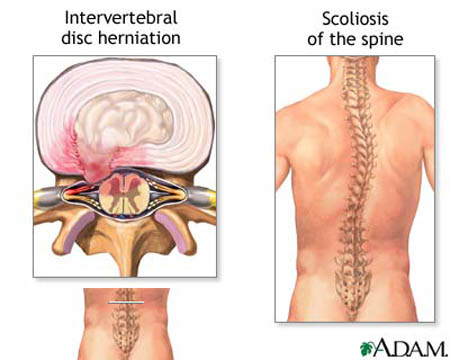Herniated Nucleus Pulposus - treatment and symptoms

Herniated Nucleus Pulposus - Damage to the structure of the CARTILAGE that cushions the vertebrae, also called a herniated, slipped, or ruptured disk. A herniated nucleus pulposus becomes increasingly common with advancing age, the result of wear and deterioration of the tough outer cartilage (called the annulus fibrosus) that allows the soft inner portion of the disk (called the nucleus pulposus) to bulge beyond its enclosure. Often there is a clear tear in the outer cartilage (a rupture). A traumatic injury, such as a motor vehicle accident, or heavy lifting may also cause a disk to herniate.
This deterioration and bulging is common enough that doctors believe in itself it does not represent a health condition that requires treatment. However, the situation becomes problematic when the herniation places pressure against the roots of the SPINAL NERVES or the SPINAL CORD, causing PAIN and weakness or numbness in the leg (typically only one leg). Though symptoms may seem to start suddenly, they reflect processes that usually have been under way for a considerable time.
Symptoms of Herniated Nucleus Pulposus and Diagnostic Path
The main symptom of herniated disk is sharp, shooting pain in the low back and in the leg (called radiculopathy). The pain in the leg is more significant for many people, and the leg may feel weak or numb in certain areas, depending on which spinal NERVE roots the herniation compresses. Some people experience discomfort in both legs, may have difficulty walking, and may have partial or complete loss of bladder or bowel function.
Sudden loss of bladder or bowel control is a serious symptom that requires immediate evaluation from a doctor.
The diagnostic path begins with a comprehensive medical examination, including NEUROLOGIC EXAMINATION and detailed PERSONAL HEALTH HISTORY. Diagnostic imaging procedures such as X-RAY of the spine, COMPUTED TOMOGRAPHY (CT) SCAN, MAGNETIC RESONANCE IMAGING (MRI), and myelography (dye injected into the spinal column and viewed with X-ray) often reveal the location and severity of the herniation. The doctor may also request nerve conduction studies and electromyogram (EMG) to assess neuromuscular function. It is possible for diagnostic tests to be unable to pinpoint the precise cause of the symptoms, which does not necessarily rule out herniation.
Herniated Nucleus Pulposus Treatment Options and Outlook
Most doctors prefer, and most people respond to, conservative, nonsurgical treatment that targets relieving the pain and INFLAMMATION. Such an approach may include
- NONSTEROIDAL ANTI-INFLAMMATORY DRUGS (NSAIDS)
- heat or cold to the area
- limited activity for two to three days to allow the inflammation to subside
- MUSCLE RELAXANT MEDICATIONS to relieve MUSCLE SPASM
- structured, progressive PHYSICAL THERAPY including strengthening exercises for the back and proper techniques for lifting
- gradual return to regular activities
When pain is severe or does not respond to oral medications the doctor may inject the area with a corticosteroid medication in combination with a local anesthetic. Such an injection typically provides rapid and direct relief that lasts from several weeks to several months and may be sufficient to heal the damage to the disk.
A small percentage of disk herniations continue to cause pain and interfere with normal activities after conservative treatment efforts. In such situations, the doctor may recommend LAMINECTOMY, a surgical OPERATION to remove the damaged disk. Health experts strongly encourage a second opinion consultation with another doctor who specializes in treating back conditions before agreeing to back surgery. Though successful back surgery both relieves pain and restores function, complications are high enough to have earned designation as a health condition themselves: failed back surgery syndrome (FBSS). Both orthopedic surgeons and neurosurgeons perform surgeries for conditions of the spine; it is often valuable to have opinions from each type of doctor before making a decision about back surgery.
Risk Factors and Preventive Measures
The key risk factors for herniated nucleus pulposus are age and sudden stress to the back such as heavy lifting or traumatic injury. Cigarette smoking accelerates normal processes of deterioration and reduces the flow of BLOOD to the structures of the spine. Regular physical exercise to strengthen back muscles and abdominal muscles improves support for the spine, helping maintain proper alignment of the vertebrae to reduce wear and deterioration. Proper lifting methods reduce strain on the back. Though there are no measures to prevent herniation, such measures help protect the spine from injury that exacerbates other factors. Most people recover from an episode of ACUTE PAIN with conservative treatment and are able to return to their regular activities.
See also BACK PAIN; CHRONIC PAIN; SCIATICA; SMOKING CESSATION; SURGERY BENEFIT AND RISK ASSESSMENT.
Open discussion on the topic Herniated Nucleus Pulposus - treatment and symptoms
Similar interests
- Nuovi Casino
- Casinos Not On Gamstop
- UK Casinos Not On Gamstop
- Casinos Not On Gamstop
- UK Casinos Not On Gamstop
- Casino Non Aams Italia
- Slot Sites Not On Gamstop
- Meilleur Casino En Ligne
- Non Gamstop Casino Sites UK
- Meilleur Casino En Ligne
- Casino En Ligne France
- Best Non Gamstop Casinos
- Casinos Not On Gamstop
- UK Casino Not On Gamstop
- Casinos Not Signed Up To Gamstop
- Best Slot Sites UK
- Non Gamstop Casino Sites UK
- Online Casinos Nederland
- Online Casinos Nederland
- Casinos Not On Gamstop
- Best New Uk Casinos Not On Gamstop
- Casino Non Aams
- Non Gamstop Casinos UK
- Migliori Siti Casino Non Aams
- Bitcoin Casinos
- Sites De Paris Sportifs Belgique
- Bookmaker Non Aams